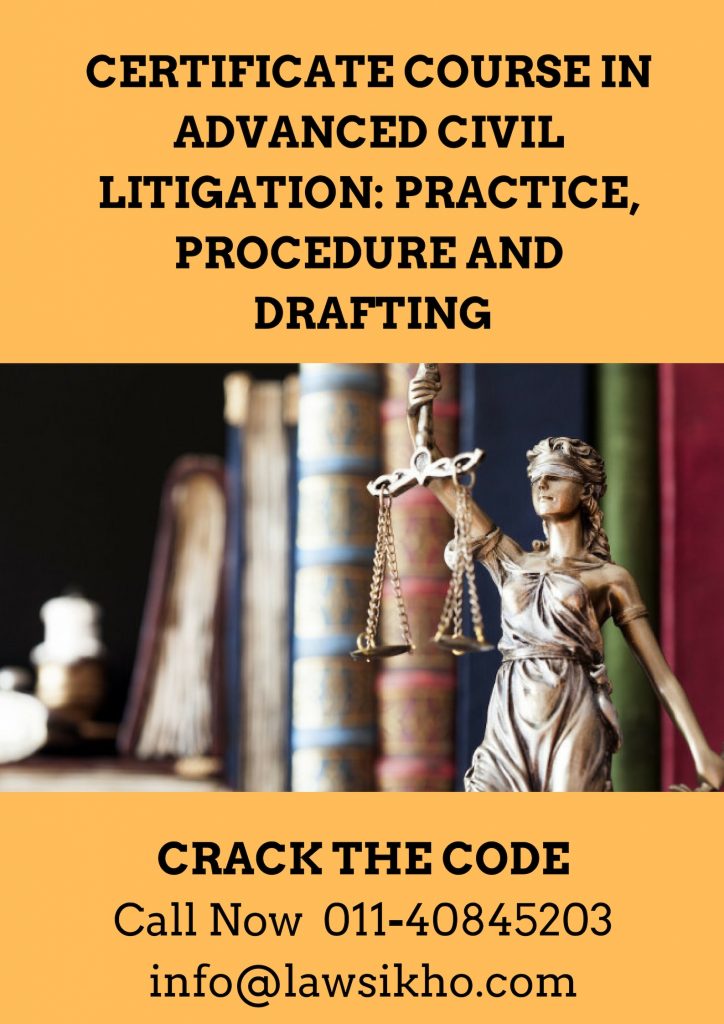This article has been written by Ritu Aggarwal, pursuing the Certificate Course in Advanced Civil Litigation: Practice, Procedure and Drafting from LawSikho.
Table of Contents
Introduction to Caveat Petition
Caveat petition is filed under Section 148 of the Civil procedure Code. Caveat generally means “a warning or caution, beware”. It is a popular term which is used in Law to point out that there could be a hidden problem to warn someone. In Law, it is understood as formal notice or warning given by an interested party to a court, judge, or ministerial officer in opposition to certain acts within his or her power and jurisdiction. The Court basically explains Caveat as a caution or warning given by a person to the court that the court should not pass any judgement, ex-parte order/order before giving prior notice or without hearing the person who can be called a caveator.
Purpose and Scope of the Section
The main purpose of this section is to protect the interest of the Caveator, who may need to face the proceedings, which is likely to be filed by his opponent. This section is also important to save the cost and convenience of the Court as it can avoid the multiplicity of the Court.
Section 148 of the Civil Procedure Code mentions
[148 A. Right to lodge a caveat.— (1) Any person who is claiming the right to appear before the court may file a caveat where an application is expected to be made or has been made, in a suit or proceeding instituted, or about to be instituted, in a Court.
(2) The caveator (who lodged the caveat under subsection (1) shall issue a notice of the caveat on the person who has filed an application or who is expected to make an application by registered post, acknowledgement due.
(3) In case, a caveat has been lodged by the caveator, under sub-section (1), the court shall serve a notice to the caveator of any application filed in any suit or proceeding.
(4) In case, a notice of any caveat has been served on the applicant, the applicant shall furnish a copy of application along with its supporting to the caveator at his expense henceforth.
(5) The caveat filed by the caveator shall be valid for 90 days from the lodging of the caveat unless the application referred to in sub-section (1) has been made before the expiry of the said period.]
The main ingredient, which explains how to file the caveat, in the section stated above are:
- Who is the right person to file caveat?
- A person who claims the right to be present before the court irrespective of the person being a party to the suit or not. This is substantive in nature as even a third party to the suit but not a stranger to the suit can file the caveat, if it has the right to appear before the court. The Court has opined in the matter of Kattil Vayalil Parkkum Koiloth v. Mannil Paadikayil Kadeesa Umma that a complete stranger to the suit or proceedings cannot file the petition of Caveat.
- A person who claims the right to appear before the court in the case, any application is expected/has been made before the court.
- In any of the suits or proceedings which has been/about to be instituted before the Court, a person claiming the right to appear can file the Caveat.
- It is important for a person who lodged the caveat to serve the notice on the person against whom the application has been made.
- The court shall be serving a notice to the Caveator regarding the application. This is a Mandatory clause in nature
- The applicant shall serve the copy of the application, copies of any paper, documents etc to the Caveator at his expense, in case notice is served upon the applicant by the court. It is a directive clause in nature.
- The Caveat which has been lodged by the Caveator shall remain in force for 90 days, however, in case the application has already been filed or already exist before the expiry of 90 days, then this clause shall not be effective.
Where can a Caveator lodge the Caveat?
Whenever a person foresees that any legal suit or proceedings are going to be filed against him, he can lodge a caveat petition in any of the civil courts including small court, tribunals etc. subject to it having original jurisdiction or any of the appellate court. It is important to note that Section 148A of CPC applies only to the civil proceedings, it cannot be applied for criminal proceedings or any of the petitions filed under article 226 of the Constitution of India as explained by the Court in the case of Deepak Khosla v. Union of India & Ors.
In the above-mentioned case, the petitioner filed a complaint against certain persons claiming that those persons had committed the offence u/s 120B, 409, 477A under Indian Penal Code. However, the Investigation Officer submitted a cancellation report after finding no offence against those persons. Petitioner filed the case before the Additional Chief Metropolitan Magistrate. ACMM, after finding prima facie offence, did not accept the cancellation report. Further ACMM, directed to summon the accused person u/s 204 of CrPC.
Petitioner was happy. However, he was afraid that accused persons who were summoned by ACMM may file the petition u/s 482 of CrPC or Article 227 of the Constitution of India and may seek and get the ex-parte interim order. Hence, the petitioner wants to put Caveat on them. Therefore, petitioner lodged a Caveat Petition u/s 148A read with sec 151 of CPC mentioning that any such petition by accused shall not be listed by Court without giving 5 days’ notice to Caveator and no ex – parte order shall be passed without giving notice to the petitioner which was challenged by registry mentioning that the Caveat petition filed in CPC cannot be entertained in the criminal proceedings. Accordingly, the petition was dismissed in absence of any provision for Caveat in Cr.P.C.
What if the Court or Applicant does not give notice to Caveator?
It is important to note that in case, Court or the applicant does not give the notice to the Caveator who has filed the Caveat petition, the order or decree which has been passed without giving the notice becomes null and void.
Filing of the Caveat and Documents requirement
- Caveat Petition shall be signed by the Caveator. However, in case an advocate is representing the Caveator, it can be signed by the advocate as well, in such case, Vakalatnama should be accompanied.
- The Caveat which has been presented before the Court shall be registered in the Caveat register in the form of a suit or proceeding or any other form as prescribed. The Caveat Register includes the number of proceedings and date, which is maintained by the Court.
- It is mandatory to file the Caveat to the Court along with the copy of the application, dispatch proof and explanation to the Court that a duplicate copy of the Caveat petition has already been dispatched to the parties to the suit.
- Generally, a Court fee of Rs 100 is charged to lodge a Caveat. It may differ for different Courts; however, the similar procedure and formats are being followed by all the Courts.
However, it is important to note that while filing a Caveat Petition to the High Court, the following steps shall be taken care of:
- Every petition shall be supported by an affidavit which shall be signed by the caveator along with the petition.
- A vakalatnama, a proof of the dispatch of the notice of caveat to the other party, any order which has been challenged, shall be submitted to the court along with the other mandatory documents.
A caveat/Notice which is given by the Caveator to the Court shall have the below-mentioned information:
- Name and Address of the Caveator so that notice/information can be sent by the Court to the Caveator
- Court name where Caveat is filed.
- No. of Appeal or suit, if any.
- Information regarding suit or appeal which is anticipated to be filed.
- Names and details of the Plaintiff or respondent or any applicant who may file the suit or appeal.
Following is the format to file the Caveat in the Delhi High Court:
http://www.delhihighcourt.nic.in/writereaddata/upload/Downloads/DownloadFile_KUD67PSJ.PDF
CAVEAT
IN THE HIGH COURT OF DELHI AT NEW DELHI
Original /Appellate Civil Jurisdiction
Caveat No.____________ of 2002
In the matter of a suit/ appeal/ proceeding instituted (give the particulars) or expected to be instituted, by
_______________________________________________ Petitioner (s)/Appellant(s)
Versus
_____________________________________________________ Respondent (s)
To
The Registrar
Delhi High Court
New Delhi
Let no order (here state in detail the precise nature of the order (apprehended) _____________________________________________________ be made in the above matter without notice to the undersigned.
Name & address of the
Caveator and his counsel, if any,
File on __________________________
Few mistakes which occur while filing of Caveat Petition
Some of the common mistakes which generally occur while filing of the caveat Petition are as follows:
- A caveat can only be filed against an application; however, it is often filed in support of the application which should not happen.
- As per Section 148A, it is mandatory for the Caveator to dispatch a notice to the applicant. However, it has been observed by the court in many cases that the Caveator has not sent or forgotten to send the notice to the applicant.
- It is important to note that Section 148A contains the limitation clause, hence, notice is required to be given within the timeframe mentioned under the section.
Conclusion
In order to conclude or summarize, a petition filed by Caveator is precautionary in nature which is filed by the people which can foresee that some case is going to be filed in the court against him and if any order is passed without taking his view into consideration, then his interest can be suffered. In case, any application within a time frame of 90 days of filing the caveat, then it is mandatory to the court to serve the notice to the caveator informing him about such application, in the absence of which, the order passed by a court shall become null and void.
References
- http://delhihighcourt.nic.in/courtrules.asp
- http://www.legalserviceindia.com/legal/article-590-whether-caveat-application-is-legally-permissible-to-be-filed-under-section-148-a-of-cpc.html
- https://indiankanoon.org/doc/61589326/
LawSikho has created a telegram group for exchanging legal knowledge, referrals and various opportunities. You can click on this link and join:
 Serato DJ Crack 2025Serato DJ PRO Crack
Serato DJ Crack 2025Serato DJ PRO Crack











 Allow notifications
Allow notifications



